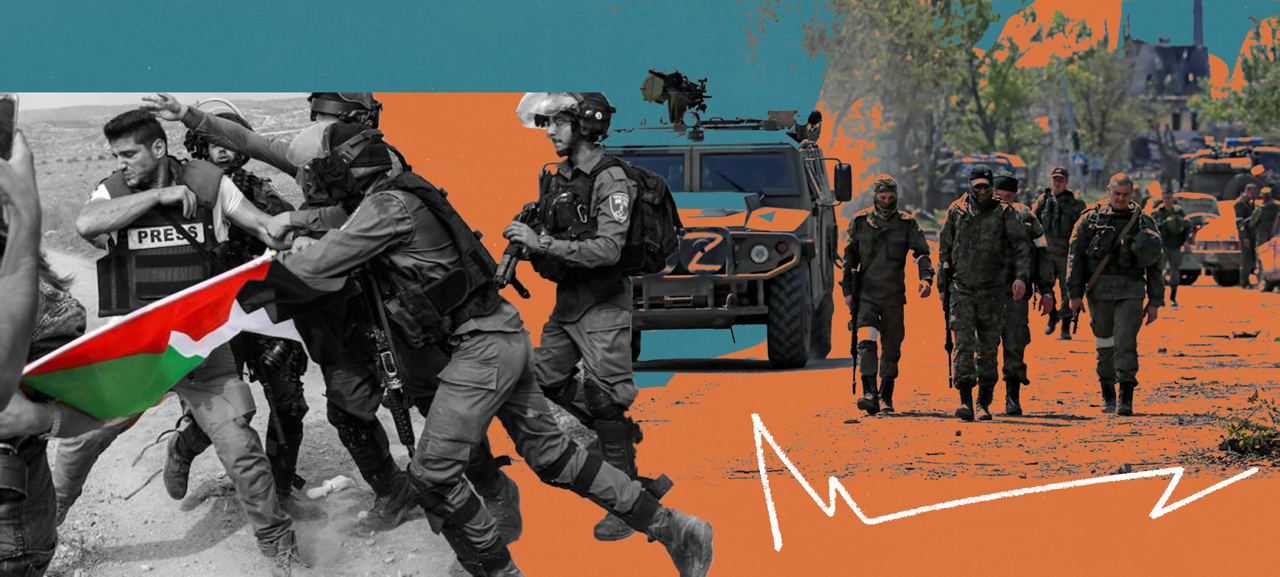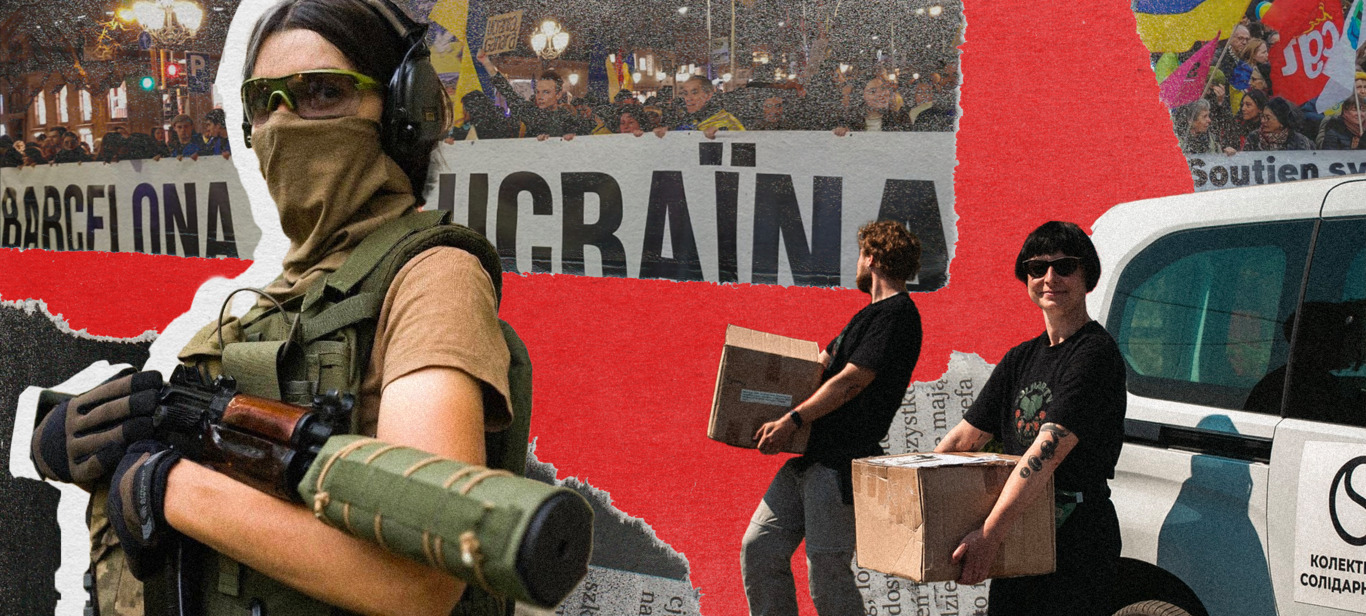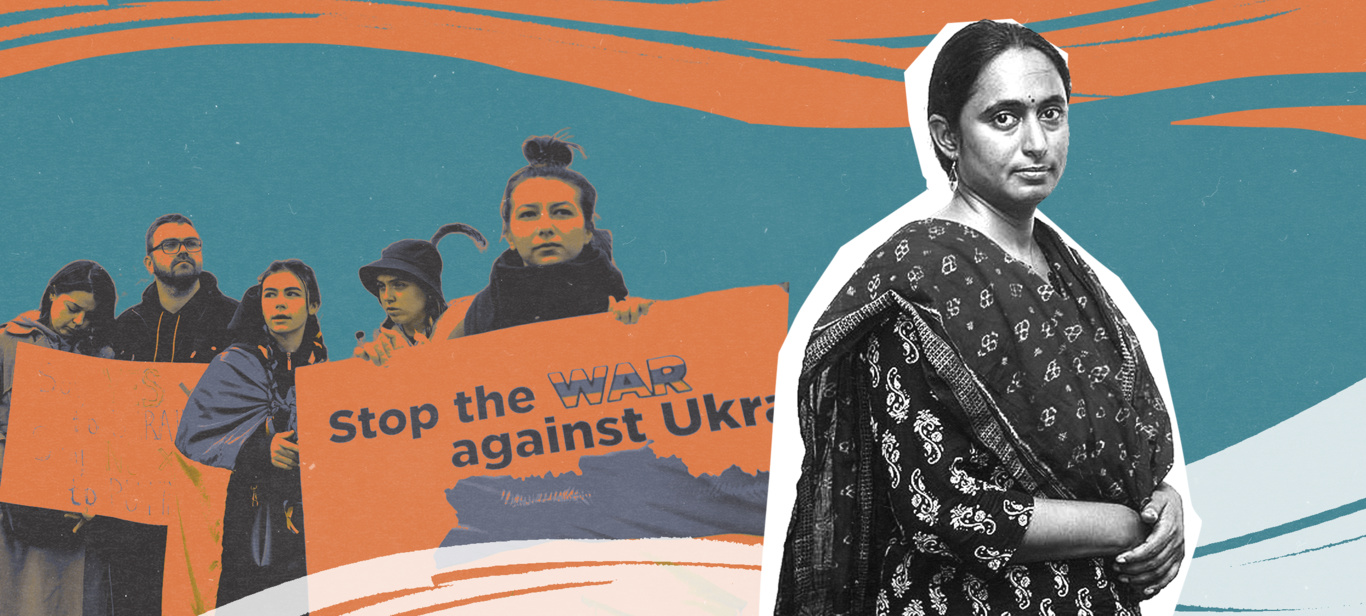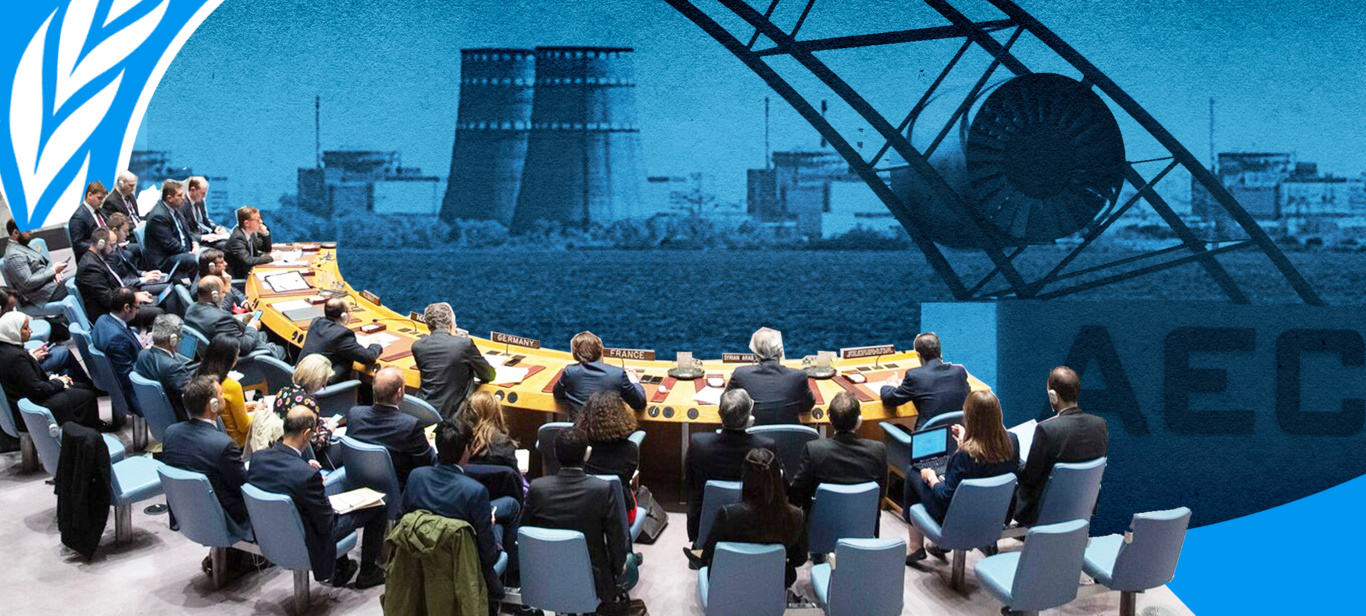On the Easter weekend, on the latest gigantic march in London against UK complicity in Israel’s war on Gaza, a group of us took a banner that said “From Ukraine to Palestine, occupation is a crime”. We were welcomed by marchers around us, and people took up our slogan.
But beyond a slogan, what can we, in the labour movement and social movements in the UK, do about these conflicts that are transforming the world we live in, and heightening fears of bigger, bloodier wars?
I suggest some answers here, based on the idea that we are dealing with the decline of two empires, American and Russian[1]. Of course neither is an empire in the strict sense of the word. By American empire, I mean the US’s economic dominance in world capitalism, and the military and political system that supports it, in which Israel is a key element. Russia, by contrast, is an economically subordinate, second-rate power, trying to reassert its dominance in the Eurasian geographical space.
My focus is on Russia’s war on Ukraine, and how it is changing, in the context shaped by the war in Gaza. The sections of the article cover (1) things I think have changed in the last six months, (2) how Russia has changed since 2022, (3) the prospects for Ukraine, (4) the role of the western powers in Russia’s war, (5) “democracy” and “authoritarianism”, (6) the dangers of a wider war, and some conclusions[2].
1. What has changed
First is the exceptional and shocking violence of Israel’s war. More than 33,000 Palestinians have been killed, mostly women and children, in six months. Civilians are subject to collective punishment, starvation is mobilised as a weapon of war. Multiple war crimes are recorded and reported daily. Israeli soldiers boast about their crimes on social media; some civilians boast about blocking humanitarian aid. Israeli politicians openly declare war aims amounting to genocide and ethnic cleansing. Here in the UK, the response by a new generation of protesters, who are not just marching but taking direct action against arms factories, is a sign of hope.
Second is the support for the genocidal onslaught by the US, UK, German and other western governments. The pace is set by Israeli prime minister Binyamin Netanyahu and the deranged extremists in his coalition government; the western powers follow. The frenzied witch-hunt against opponents of Israel’s war is unprecedented. But with every new shocking image and every new demonstration demanding a ceasefire, another thread is pulled from the fabric of the grand fiction, that Israel is defending the Jewish people and that to question its actions is antisemitic. Gigantic cracks are opening up in the ideological foundations of the Zionist project.
Third is the way that hundreds of millions of people across the world have understood, and been infuriated by, the hypocrisy of western politicians who condemn ethnic cleansing by Russia, but enable it in Gaza.
Fourth is the way that the absence of a state or state-supported army has made Israel’s civilian victims so horrifyingly defenceless. Again, there is a contrast. Russia’s onslaught on Ukraine has been stymied not just by the powerful moral force of popular resistance, but by weapons. Many of these have been delivered to the Ukrainian armed forces by the US, UK and other governments that are now facilitating Israeli terror in Gaza.
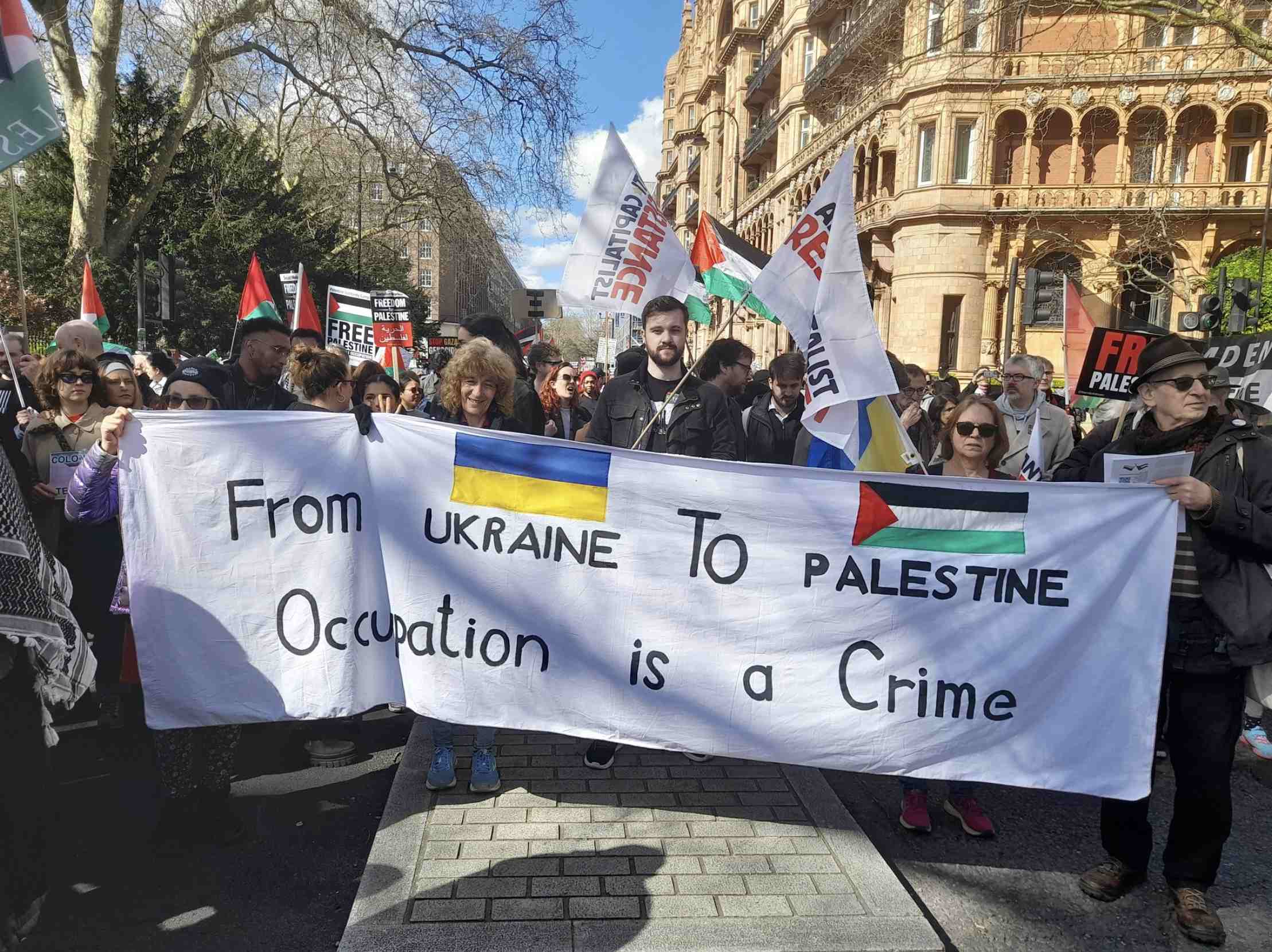
London, 30 March 2022, on the rally calling for a ceasefire in Gaza
Fifth, faced by these two wars, the political paralysis of sections of the western labour movement is all the more striking. Those who embrace “campism” and one-sided “anti-imperialism” denounce the US and Israel, but can not bring themselves to look at the Russian empire through the same lens. The Russian state’s shift towards fascism, the imperialist character of its war, and the horror it has imposed on the occupied parts of Ukraine, is all a blind spot. Three decades after the collapse of the Soviet Union, the movement and its internationalism are being undermined by this “campism”, Stalinism’s monstrous grandchild.
2. Russia’s war
The Ukrainian socialist Hanna Perekhoda has written recently about the Russian war’s imperialist character, and the Russian socialist Ilya Budraitskis has offered a powerful argument about the Kremlin’s wartime shift towards fascism[3]. Here I make two points that I think support and develop their arguments: about how the war is fought, and how economic policy is being adapted to fight it.
Russia’s war is, firstly, a war on Ukraine’s civilian population. The gigantic missile and drone attack on 21-22 March, which targeted Kharkiv (Ukraine’s second city), Zaporizhzhia and Kryvyi Rih, was a reminder. Ukraine’s largest hydro power station, on the Dnipro river, was ruined and DTEK, the largest power company, said 50% of its generating capacity was down. “Russia is causing civilian casualties, including workers at their workplaces, and is actively destroying Ukraine’s economy and energy industry”, the Confederation of Free Trade Unions of Ukraine said.
Reports by the United Nations and non-governmental organisations, summing up the destruction wrought in the two years since the Russian invasion of 24 February 2022, have underlined the Russian focus on civilian targets.
A Two-Year Update from the UN High Commissioner for Human Rights confirmed more than 10,000 civilian deaths and nearly 20,000 injured; “the actual numbers are likely significantly higher”. The vast majority of these people were killed by “explosive weapons with wide-area effects” – a little more than one in seven in occupied areas (i.e. mostly likely by Ukrainian bombing), the rest in government-controlled areas (most likely by Russian bombing). Evidence about war crimes points the same way: multiple UN reports show that that the vast majority, but not all, have been committed by Russian forces.
Over time, researchers have learned more about the Russian siege of Mariupol, a key event in the 2022 invasion. A 230-page report by Human Rights Watch and Truth Hounds concluded that at least 8000 people there died from war-related causes. Bodies are buried in mass graves and the true number may never be known. The onslaught damaged all of Mariupol’s 19 hospitals and 86 of its 89 schools and colleges. Findings by the UN independent international commission of inquiry were complementary.
A distinguishing feature of Russia’s war is its readiness to sacrifice its own troops for a few kilometres of ground, reminiscent of the first world war. This was how Russia captured the strategically significant town of Avdiivka in Donetsk last month, as it did Bakhmut in 2023. (See e.g. press reports here, here and here, and open-source-based analysis here.) Since February 2022, Russia has probably lost 75,000 dead, plus an unknown number from the Donetsk and Luhansk “republics”, while Ukraine may have lost 42,000 dead. Military injuries are thought to be more than 300,000 Russians and 100,000 Ukrainians[4].
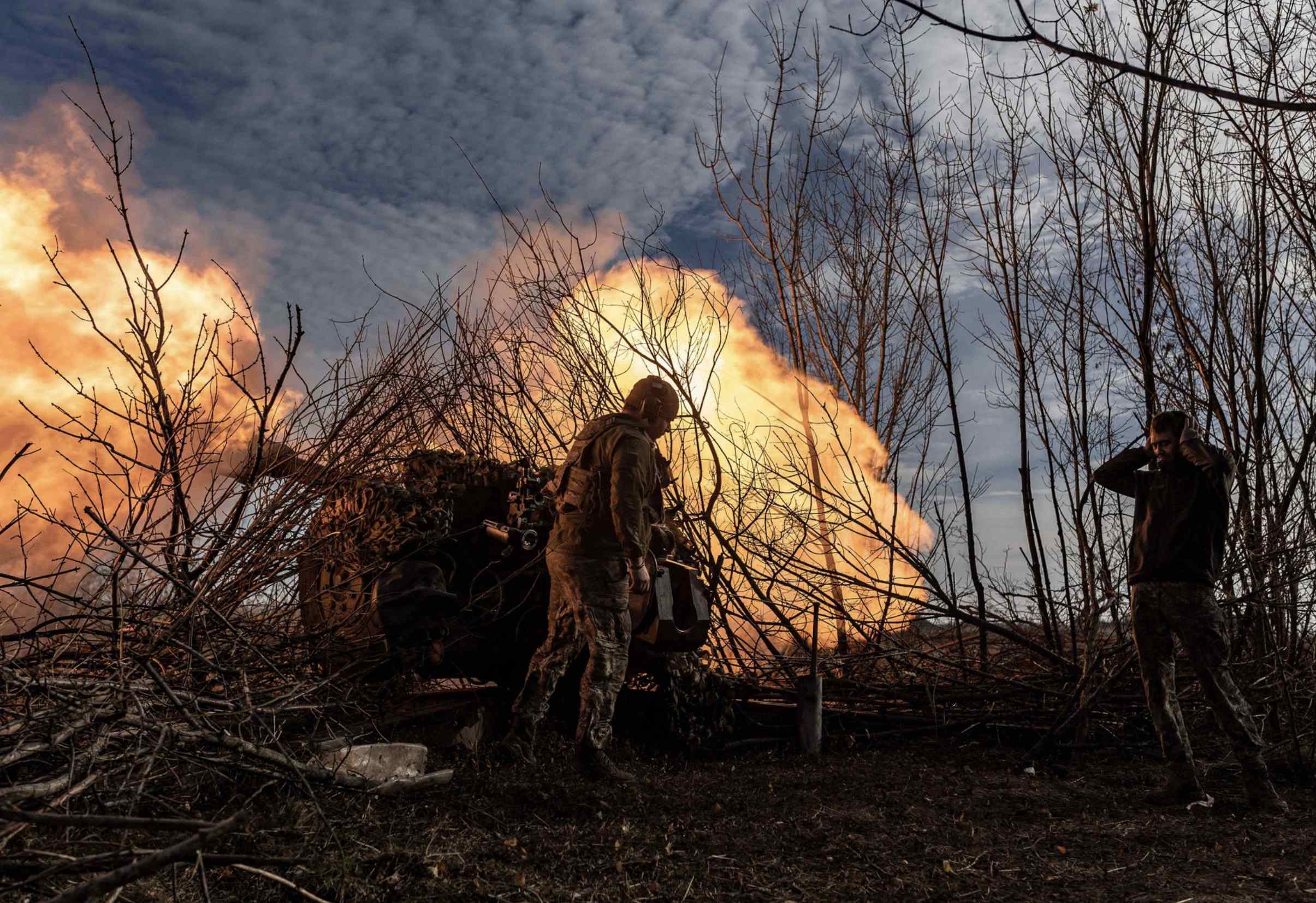
The moment of the attack of the Armed Forces of Ukraine on the positions of the Russian troops near Bakhmut from artillery weapons. Photo: Diego Herrera Carcedo / Anadolu / ddp / Vida Press
Another key feature of Russia’s war is its administration of the territories it has occupied, which brings into the 21st century the ethnic cleansing, petty tyranny and cultural thuggery that the British empire pioneered in the 19th century. A brilliant example of Russia’s supremacist sickness: Sergei Mironov, the leading parliamentarian, who last year adopted a child stolen from an orphanage in occupied territory.
The occupied areas have been militarised, and civil rights trashed. (I published an overview recently.) The authorities’strategy of forcibly expelling Ukrainian civilians and encouraging in-migration by Russian civilians has been monitored by NGOs[5]. Resistance, driven underground in 2022, is spreading again, in the first place through covert networks of women activists. There lies hope.
Russia’s economic strategy has been transformed by the war. This shift to “military Keynesianism” could be a key factor in spreading war in and beyond Ukraine.
The budget has been pumped up by surging oil revenues, and these funds channelled into the military and associated industries. The state is also reordering company ownership, turning assets over to new security-services-connected sections of the elite, and forcing exile oligarchs to bring their wealth back to Russia or sell up.
In response to the 2022 invasion, the western powers imposed an unprecedented bundle of sanctions on Russia: there are now 13,000 measures in place, more than those against Iran, Cuba and North Korea combined. These sanctions have not cut off the oil revenues that sustain the Russian budget: in section 4, below, I question whether they were ever meant to. But they did freeze Russia’s foreign exchange reserves and constrain its banks. The Kremlin reacted by banning the withdrawal and export of cash, hiking up interest rates and putting capital controls in place. Oil exports were rerouted to Asian destinations.
Spending on the war has ballooned. Budget spending on the military was about 3-3.6 trillion rubles ($44-48 billion, or 15% of the federal budget, or 3-4% of GDP) in 2019-21; in 2022, it leaped up to 8.4 trillion rubles ($124.5 billion); and in 2023, to roughly 13.3 trillion rubles ($160 billion, or 40% of the federal budget, or 8-9% of GDP), the economist Boris Grozovskii estimated[6]. Social payments to soldiers’ families have shot up, and industries linked to the military, such as microelectronics and electrical equipment, have expanded rapidly. Funds are being poured into the reconstruction of Ukrainian cities destroyed by Russian bombing and now occupied by the Russian army[7].
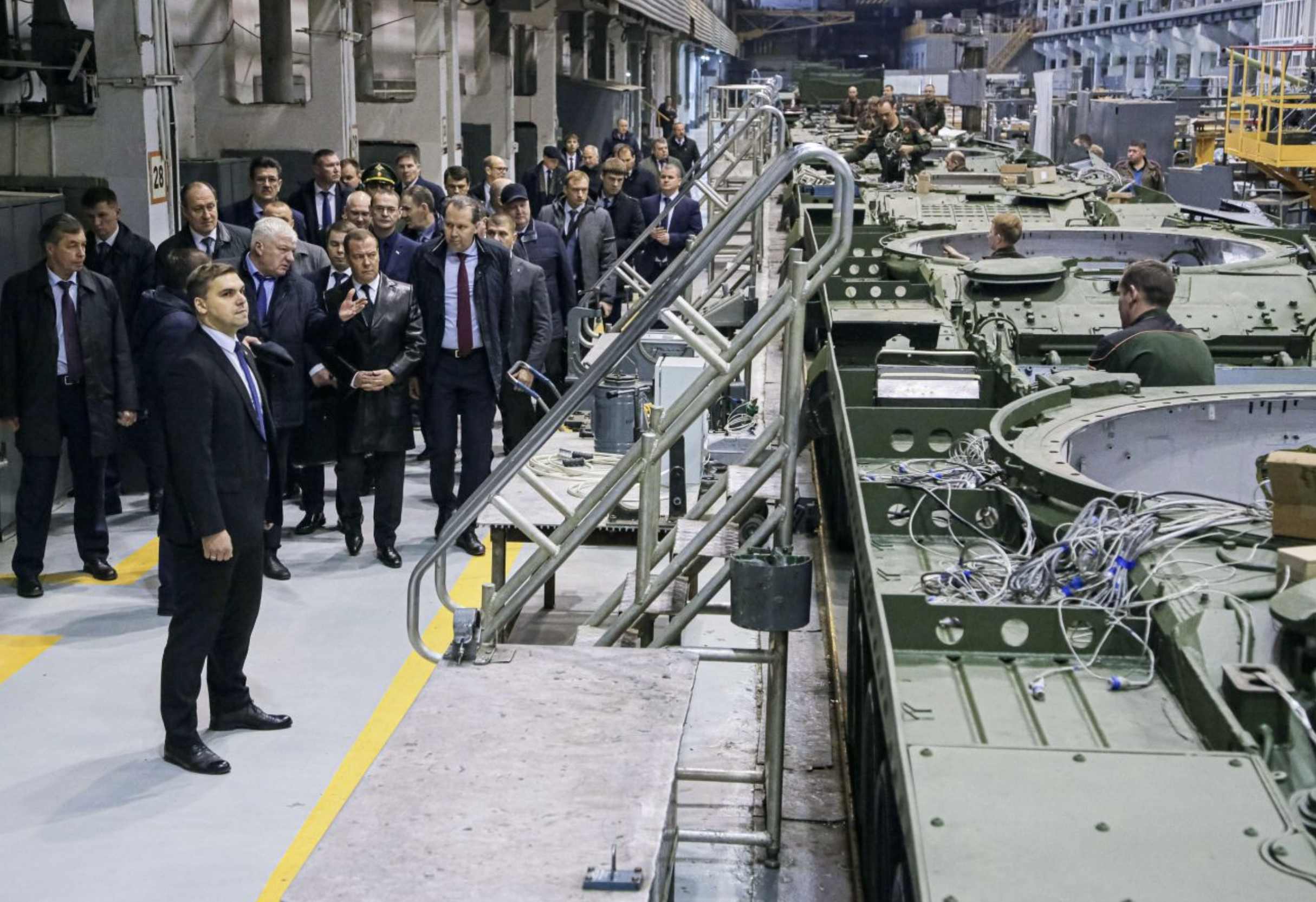
Deputy Chairman of the Security Council of Russia Dmitry Medvedev at the Uralvagonzavod. Nizhny Tagil, October 24, 2022. Photo: Press service of Dmitry Medvedev
In 2023 came a concerted effort to reorder company ownership: the prosecutor general’s office applied to the courts to nationalise more than 180 private companies. The two main targets were those needed for war production, such as the Chelyabinsk electrometallurgical plant, Russia’s largest ferroalloys maker, which was nationalised last month, and those belonging to businessmen regarded as disloyal. This year a new offensive has started: last month, the government began listing “economically significant organisations” that will compel business empires based offshore to return their money to Russia and pay dividends there; this will both shield firms from sanctions, and bring them under tighter state control[8].
The economist Alexandra Prokopenko argues that nothing less than a remaking of the Russian elite is underway – president Vladimir Putin’s second, after the 2003-07 taming of the Yeltsin-era oligarchs. The waves of nationalisation are “part of Putin’s effort to redistribute property from people seen as insufficiently loyal to the Kremlin and create a new class of asset owners who owe their fortunes to the president and his inner circle”. These new owners will be “the true winners of the Ukraine war – and a bedrock of the regime’s stability”[9].
Military Keynesianism means that productivity and competition fall, less is spent on non-military activities, and the risk of military escalation rises, Prokopenko argues. “It incentivises the Kremlin to drag out the war as long as possible, or to convert a hot war into a cold one.” The Stockholm International Peace Research Institute warns that the “new addiction” to military spending creates an even greater dependence on energy revenues[10].
The Kremlin took Russia to war in 2014, subordinating economic management, and the business interests of Russian capitalists, to geopolitical imperatives (roughly, the aspiration to great power status), imperialist expansionism and nationalist ideology. In 2022 that sacrifice of economic interests to military and political imperatives went much further. (I wrote about this e.g. here and here.) Now, the Kremlin is going still further down this disastrous road. The fascist demagogy gets more strident, the screws of domestic repression are tightened – and the economy is not just subordinated to nationalism and militarism, but remodelled to feed them. This process is producing perhaps the greatest danger of future war in Europe.
3. Ukraine’s prospects
Ukraine’s war is fought by a coalition of the Ukrainian state, the population and the western powers that supply weapons. This alliance has been strained by the disappointing outcome of Ukraine’s attempted counter-offensive last summer and the prospect of a new Russian offensive this summer. The Ukrainian army is short of both men and equipment: journalists estimated that at Avdiivka, for example, it was outnumbered by five to one (artillery), seven to one (drones) and up to 15 to one (soldiers).
It is important to put this in context. The Kremlin expected to vanquish Ukraine completely in a week, and two years later took very heavy losses, to capture the ruins of a small town it bombed extensively beforehand. But we have to deal with the world that the Kremlin has helped to create in the meantime.
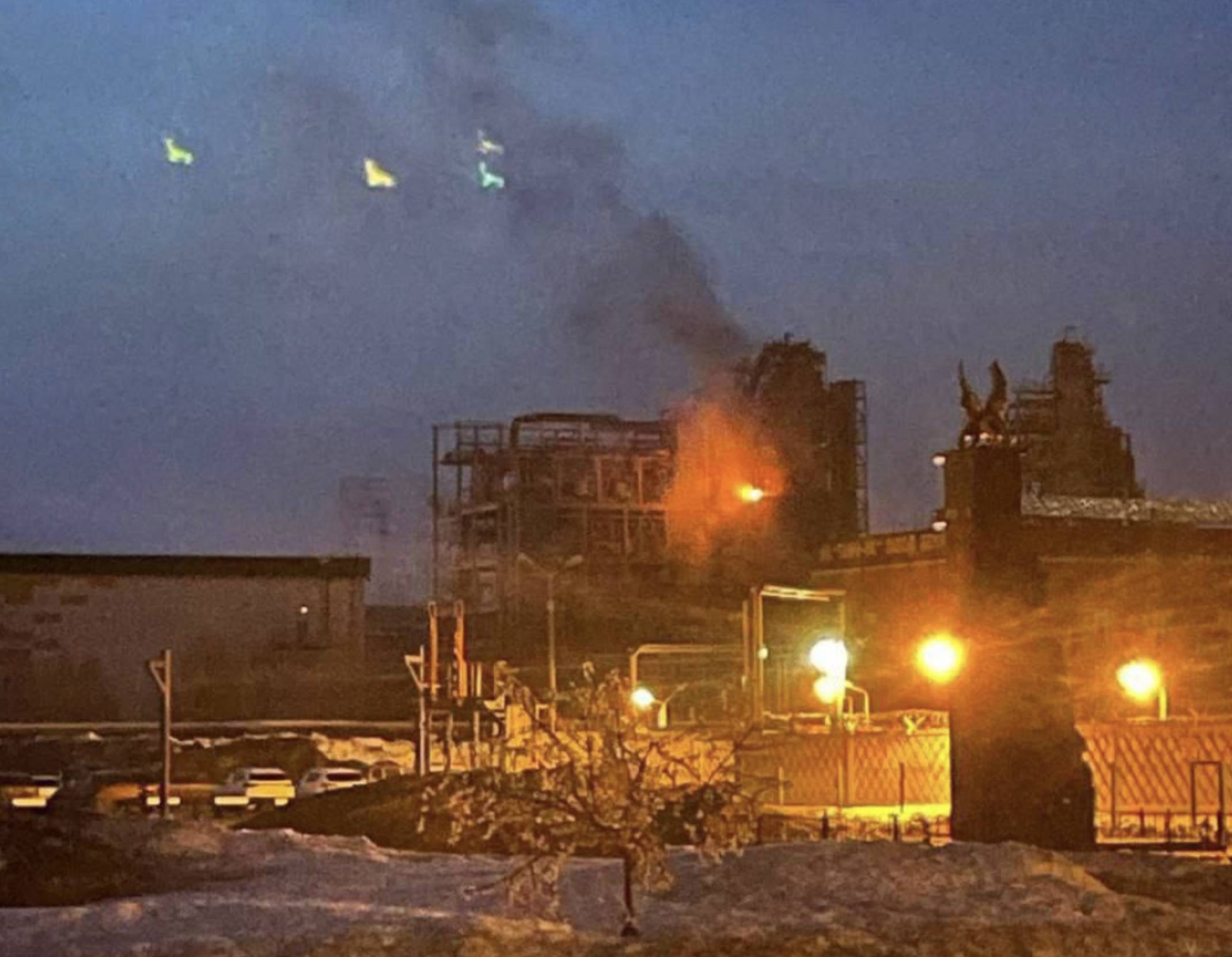
On April 2, a drone hit the Russian oil refinery at Nizhnekamsk. April 2, 2024. Photo from Telegram / Baza / Ukrainian military centre project
The shortage of men is raising tensions between the Ukrainian state and people. On 2 April president Volodymyr Zelensky signed laws lowering the age of compulsory military service from 27 to 25, creating an online register for conscripts and cancelling “partially eligible” status in medical examinations. These changes came while a new mobilisation law, that takes a broader approach and could allow about 500,000 men to be drafted, remains stuck in parliament. Parliamentarians have proposed more than 4000 amendments. Zelensky and his team are keen to distance themselves from the measures, which are unpopular: they have failed to confirm that 500,000 figure. (Ukraine currently deploys about 330,000 troops, out of a total 1.2 million people serving in the armed forces).
The heated public controversy around mobilisation should not be confused with opposition to the war, of which there is little sign. The issue is how to fight it. Serving soldiers are on average in their 40s, and some have been at the front without a break for two years. A recent survey found that 48% of men were not prepared to fight, 34% were and 18% said it was hard to say; another found that a majority of Ukrainians (54%) understood draft evaders’ motivation; and a third showed that far more people think the level of conscription is about right, or insufficient, than think it is excessive[11].
Along with a potential shortage of soldiers, the Ukrainian armed forces are suffering an acute shortage of weapons. This reflects divisions among the western countries that supply them about the point of the war (see next section). This is only partly compensated by inventive use of limited weapons supplies, e.g. to inflict serious damage on Russia’s Black Sea fleet and to attack oil refineries and airfields in Russia.
Against this background, reports appear regularly in the western press, citing unnamed sources, claiming e.g. that the US is asking Ukraine whether it would talk, or that Russia has made informal overtures to the US (see e.g. here and here). Last month Turkey offered to host negotiations.
The obstacles to peace negotiations are substantial, in my view. The Kremlin has written its claims on Ukrainian territory into the Russian constitution. It is committed to press ahead, not only by its imperialist rhetoric that denies Ukrainian nationhood, by its geopolitical aims and by the shift to “military Keynesianism”.
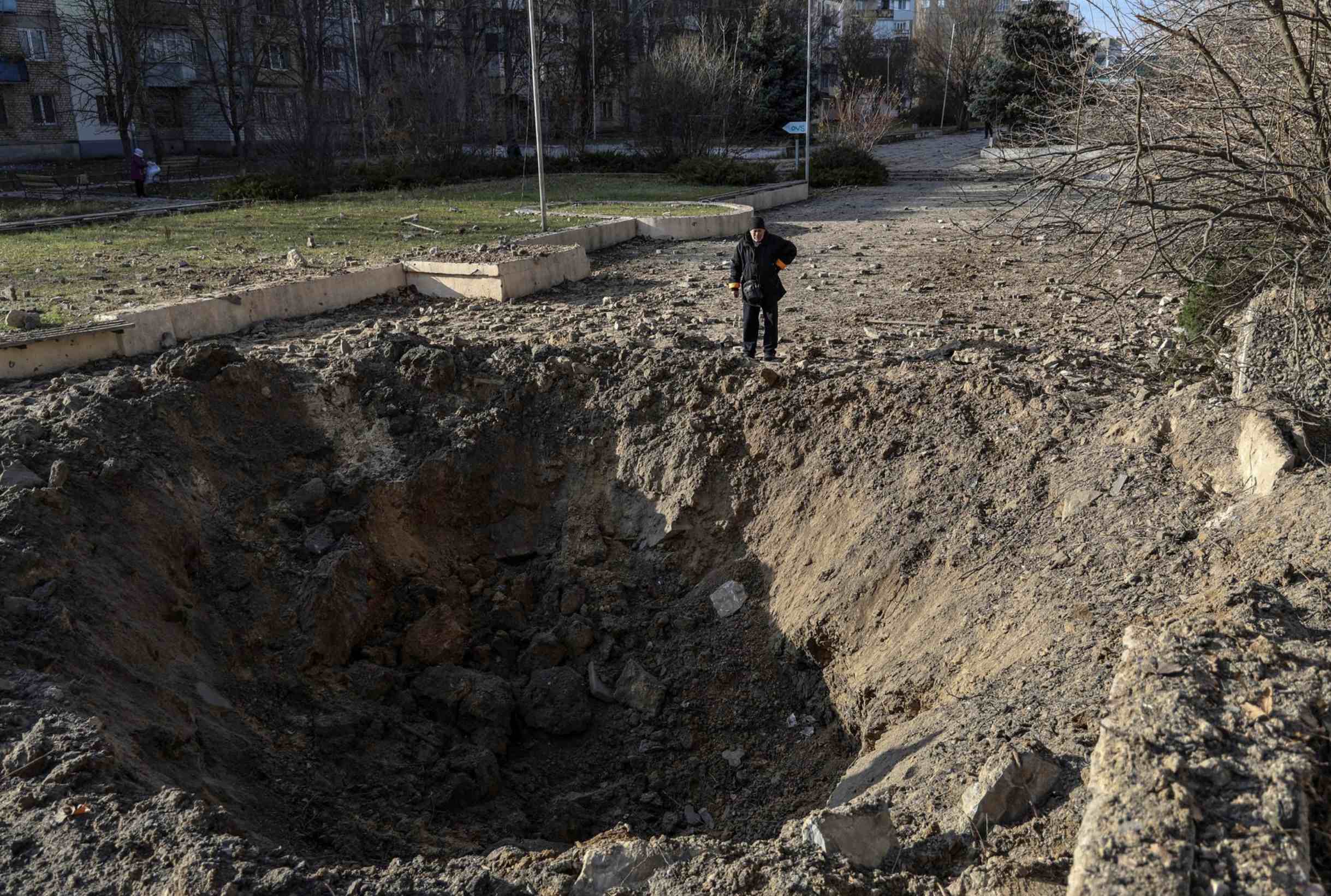
A resident of Kherson next to the ravine left after the Russian shelling. Photo: Ivan Antypenko / Reuters
I will not try to draw a picture of what is in Ukrainian people’s heads, but from my conversations and reading of the media, I would say that, for many, the desperate yearning for peace is balanced by a sense (i) that the prospect of Russia retaining control of the 18% of Ukrainian territory it now occupies, discussed in western corridors of power, is unacceptable, and (ii) more compelling, any peace settlement that allows Russia to rebuild its badly damaged armed forces and have another go, is a mortal danger. This was reflected in one of the many comments in Ukrainian media about conscription:
One of the most popular arguments with men evading the draft goes like this: if you hide from your own country’s military recruitment officers, and Ukraine suffers a defeat, then no-one will save you from the Russian military recruitment officers and the Russian commanders, who will send you to storm Krakow and Warsaw. So, better to surrender to your own Leviathan, not to the enemy’s.
My conclusion is that, until the Kremlin decides to pause, let alone stop, its aggression, no peace negotiations are in prospect. Hopefully a ceasefire that at least “freezes” the conflict is possible.
In the labour movement in western countries, it remains crucial to respond to the incessant claims that only the western powers obstruct a peace deal – claims usually made by “campists” (one-sided “anti-imperialists”) who consider that the only imperialist power is the US, and that Russia and/or China represent a potentially progressive alternative. (See linked article, No path to peace through this fantasy world.)
4. The western powers and Ukraine
Divisions about how to deal with Russia are emerging between the western powers – for geopolitical and strategic reasons, bound up with the crisis of the American empire. This is not about democratic principles, but about how to control, rather than destroy, a second-rank empire with a subordinate role in the world economy.
The Putin set-up has never been a polar opposite to the American empire. Until 2014 the western powers enthusiastically nurtured it, as it integrated Russian capital into the world system. From 2014 the relationship grew colder. Only the full-scale invasion of Ukraine in 2022 brought a final rupture. Even since then, the sanctions regime has been limited. Specifically, the American empire has ruled out measures that obstruct the supply of Russian crude oil to the world market. To understand the western powers’ attitude to Russia now, this history matters.

Queue for ATMs at the Citibank bank office, Moscow, February 28, 2022. Photo: Mykhailo Grebenshchikov
In the early 2000s, the American empire supported Putin’s military onslaught against Chechnya, and the multiple war crimes committed, as integral to his strategy to centralise and strengthen the weakened state machine. As the Russian economy recovered thanks to rising oil prices (2001-08), the western powers treated Putin as a gendarme of capital, who was given free rein in the post-Soviet space. (I have written about this e.g. here, here and here.)
From 2007, when Putin made his speech at Munich against the US-led “unipolar world”, he sought to reverse Russia’s declining role as an imperial power, although his efforts were complicated by successive economic crises (the 2008-09 crash, the oil price collapse of 2015, and the pandemic of 2020-21). But the western powers looked on impassively as Russia invaded Georgia (2008) and eastern Ukraine (2014), and as Putin helped Bashar al-Assad to drown the Syrian revolt in blood (2015-16). The American empire balked only at the annexation of Crimea, which broke numerous international agreements, and the shooting-down of a civilian Malaysian airplane over eastern Ukraine (2014).
In 2021, as the Kremlin prepared the invasion of Ukraine, the western powers actually sought to roll back some sanctions. In July that year, the US and Germany agreed to lift obstacles to the Nord Stream gas pipeline project – and only abandoned that approach when Russia recognised the rogue Donetsk and Luhansk “republics” on 21 February 2022, three days before the all-out invasion of Ukraine[12].
After the invasion, the western powers acted to cut Russia’s ties with the international financial system, and accepted that Russian gas exports to Europe will be sharply reduced, probably for good. But they have blocked all measures that would push up oil prices.
The sanctions on oil exports matter most, because oil is by far the largest source of export revenues and of payments into the Russian state budget. In December 2022, European nations had proposed a simple ban on financial services, including marine insurance, for ships transporting Russian oil. Europe’s dominance in the insurance market meant it would be enforceable, but the proposals “spooked the US Treasury”, as Global Witness reported at the time. “The US government devised the price cap with the explicit intention of keeping Russian oil flowing, while reducing revenues to the Kremlin, and corralled European countries into dropping their outright ban.”
When the price cap was adopted, it was too high to be effective – $60/barrel of crude oil – and the US also stepped in to ensure that penalties for non-compliance would be light, and that oil products refined from Russian oil would not be sanctioned. (I wrote about this here.)
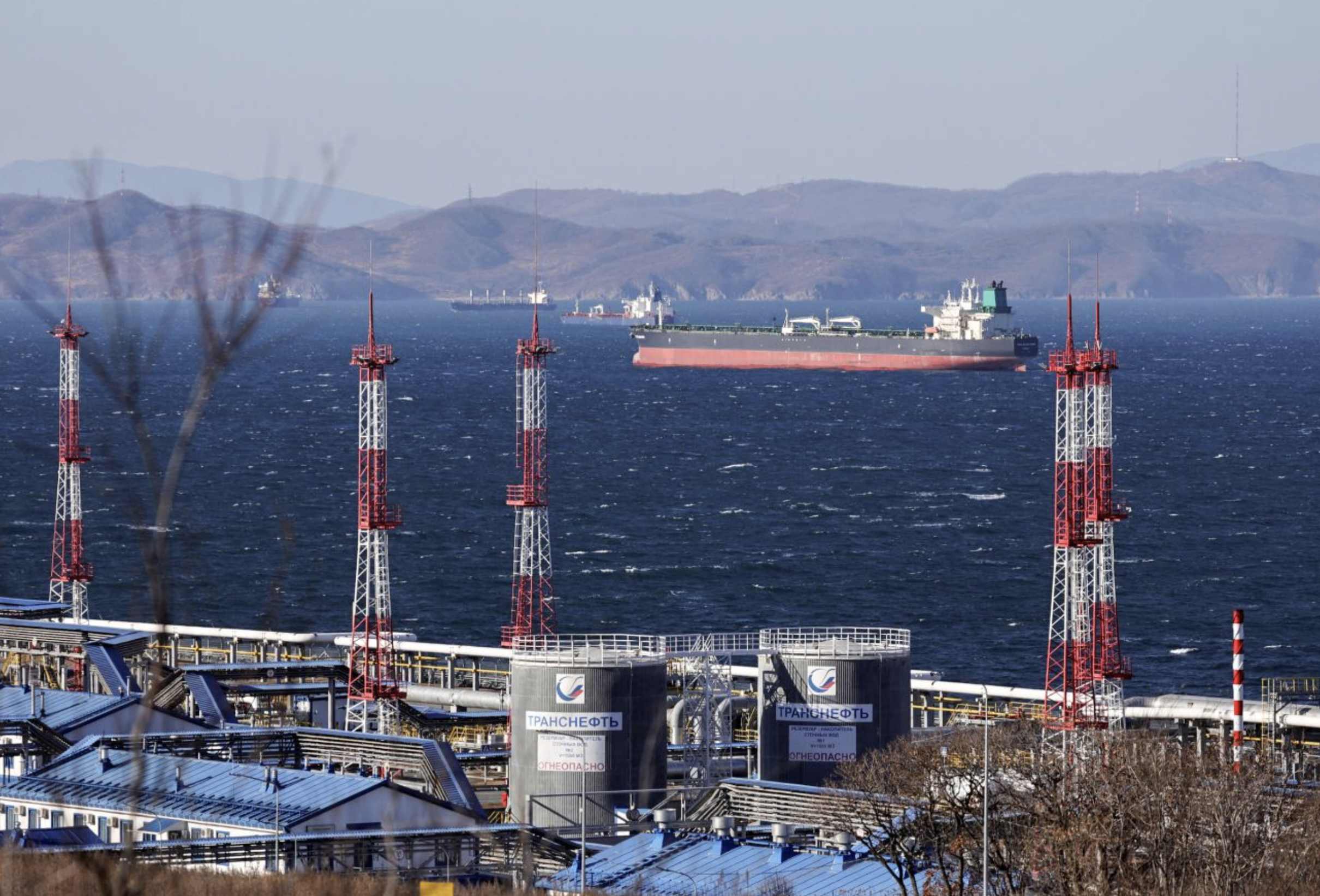
An oil tanker at anchor in Nakhodka Bay, Primorsky Krai, on December 4, 2022. Photo: Tatiana Meel / Reuters
So Russian oil is now exported to India, China and other mainly Asian destinations, refined, and re-exported to western destinations. The UK, whose politicians shout loudest about their support for Ukraine, imported an estimated €660 million of such products in the first year after the oil price cap was imposed. Along with this sanctions evasion, there is systematic sanctions busting by a “grey fleet” of ships that lack proper insurance and are owned by opaque structures.
Nothing daunted, the Ukrainian military last month hit Russian oil refineries with drone strikes. The response: a rebuke from Washington. The US is concerned about petrol prices rising in an election year, the Financial Times reported, and about Russia “lashing out at energy infrastructure relied on by the west”, such as pipelines bringing oil from central Asia through Russia. I am pleased to say that, up until I wrote this, it seems that Ukraine didn’t take much notice.
As for the chorus of western companies that in 2022 announced they would leave Russia, a Kyiv School of Economics database shows that of 3756 foreign companies working there before the full-scale invasion, only 372 have fully exited. Although the largest oil producers have ceased operations in Russia, the world’s biggest oil field services firm, SLB (formerly Schlumberger) has not. No wonder other governments put Ukraine under pressure to scrap its “sponsors of war” blacklist, resulting in the removal of the publicly available version.
5. “Democracy” and “authoritarianism”
Putin’s regime is a frankenstein monster that has turned against the American empire that once fostered it. Netanyahu’s government is a different kind of monster, highly dependent on its American master, that protects it as it lays waste to Gaza. Insofar as the western powers have an ideological narrative, to justify their opposition to Putin and support for Netanyahu, it is that they are defending “democracy” from an “alliance of authoritarian powers” including Russia, China, Iran and North Korea, as Jens Stoltenberg, the head of NATO, said this week. The labour movement and social movements must not accept this false dichotomy.
The dangers of buying into this false narrative loom over the very practical political issue of weapons supply to Ukraine. The western powers are very deliberately rationing these weapons, in line with their views of how to deal with the Kremlin – but are divided about the extent of this rationing. It is sometimes suggested in labour movement circles that these arguments reflect a split between “democrats” and “new authoritarians” in western politics. I disagree. For a start, right now it is “democrats” no less than “authoritarians” who are putting the most damaging constraints on Ukrainian resistance to Russia. To understand this I suggest we need to see it in the context of the American empire’s crisis.
Let’s start with Donald Trump. It is widely assumed that the Kremlin will keep stepping up military action in Ukraine at least until November, in the hope that Trump will win the US presidential election, and weaken western backing for Ukraine. I have no reason to doubt that the Kremlin is keeping its options open in that way, but (being anything but an expert on US politics) I think Trump is only one piece of the jigsaw of western policy.
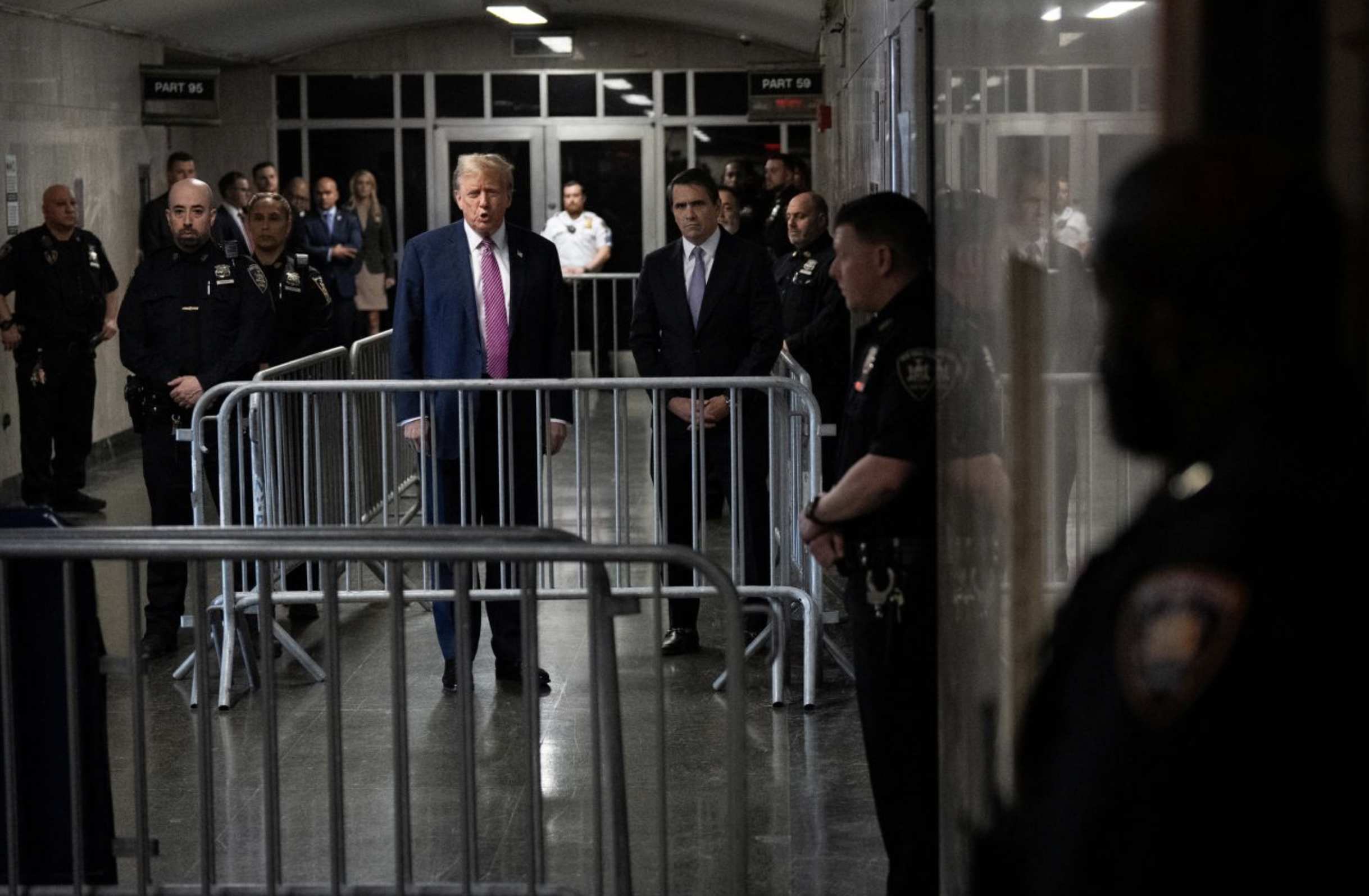
Donald Trump in the hallway of a New York courthouse after a hearing on April 19, 2024. Photo: Maansi Srivastava / Reuters
Take the decision on aid for Ukraine that passed in the US Senate and is now stuck in the House of Representatives, because Trump is putting pressure on the speaker, Mike Johnson. The delay of the aid package is damaging Ukraine militarily. Martin Wolf of the Financial Times warned that Trump “may soon hand his friend, Vladimir Putin, victory over Ukraine”.
Wolf examines the internal machinations in the Republican party, and concludes that Trump’s strength is the loyalty of the party’s base. He fears Ukraine will be “abandoned”: that would “raise questions about US reliability everywhere”; the US’s allies would doubt its guarantees; nuclear proliferation could result; alliances less dependent on the US could fill the vacuum.
In contrast to Wolf, writers at The Economist highlight the divisions in the Republican party. Should Trump win the election, they argue, his foreign policy would be chaotic – but would be influenced by Republican factions that are fundamentally opposed to each other: isolationists, with strong support in the Republican ranks (“Make America Great Again”); those who think attention should shift from Europe to the Pacific and the perceived Chinese threat to the American empire; and Reaganites, who believe in preserving US hegemony.
On balance, I expect that a Trump victory in November could well produce more constraints on arms supply to Ukraine. But let’s not lose sight of the fact that these would build on constraints already imposed under the Biden administration, on both weapons supply and sanctions. The context is the American empire’s long-term decline. The takeover of the Republican party by Trump is only one manifestation of this; the dysfunction of US governance is another; the chaotic withdrawal from Afghanistan in 2021 a third.
The weakening of the international institutions established by the American empire in the aftermath of the second world war, and specifically the United Nations, is symptomatic. The depth of the malaise can be seen in the disastrous failure of the “international community” to deal with climate change, or the series of equally destructive wars hidden from the western gaze (Sudan, Eritrea and so on).
The most graphic illustration of this empire’s crisis is its relationship with Netanyahu, who has driven Israel, and Zionism, down the most extreme of all possible roads, while the US Democrats (not Republicans) refuse to restrain him. The UN Relief and Works Agency (UNRWA), set up in 1949 to manage the Palestinian refugee crisis caused by the establishment of the state of Israel, is a victim.
This is a deep crisis of western hegemony, and can not be understood only as the evil deeds of “new authoritarians” (Trump and co), as opposed to “democrats”.
In Europe, while right-wing leaders in smaller eastern European countries such as Hungary and Slovakia hope for accommodation with the Kremlin, in Poland, the extreme right wing Law and Justice party, and Donald Tusk’s centre-right Civic Platform, both advocate strong military backing for Ukraine. The most effective response to Ukrainian pleas for aid among the richest European countries was from the UK’s Tory government, the most right wing of them. Even Giorgia Meloni’s far-right coalition in Italy (although not her deputy, Matteo Salvini) strongly support weapons supply.
In Germany, it is a leader of the Social Democrats, Rolf Mutzenich, who provoked a storm in parliament when he argued not only that Taurus missiles should not be sent to Ukraine, but that Germany should seek to “freeze the war and later end it”, presumably by concessions to Putin.
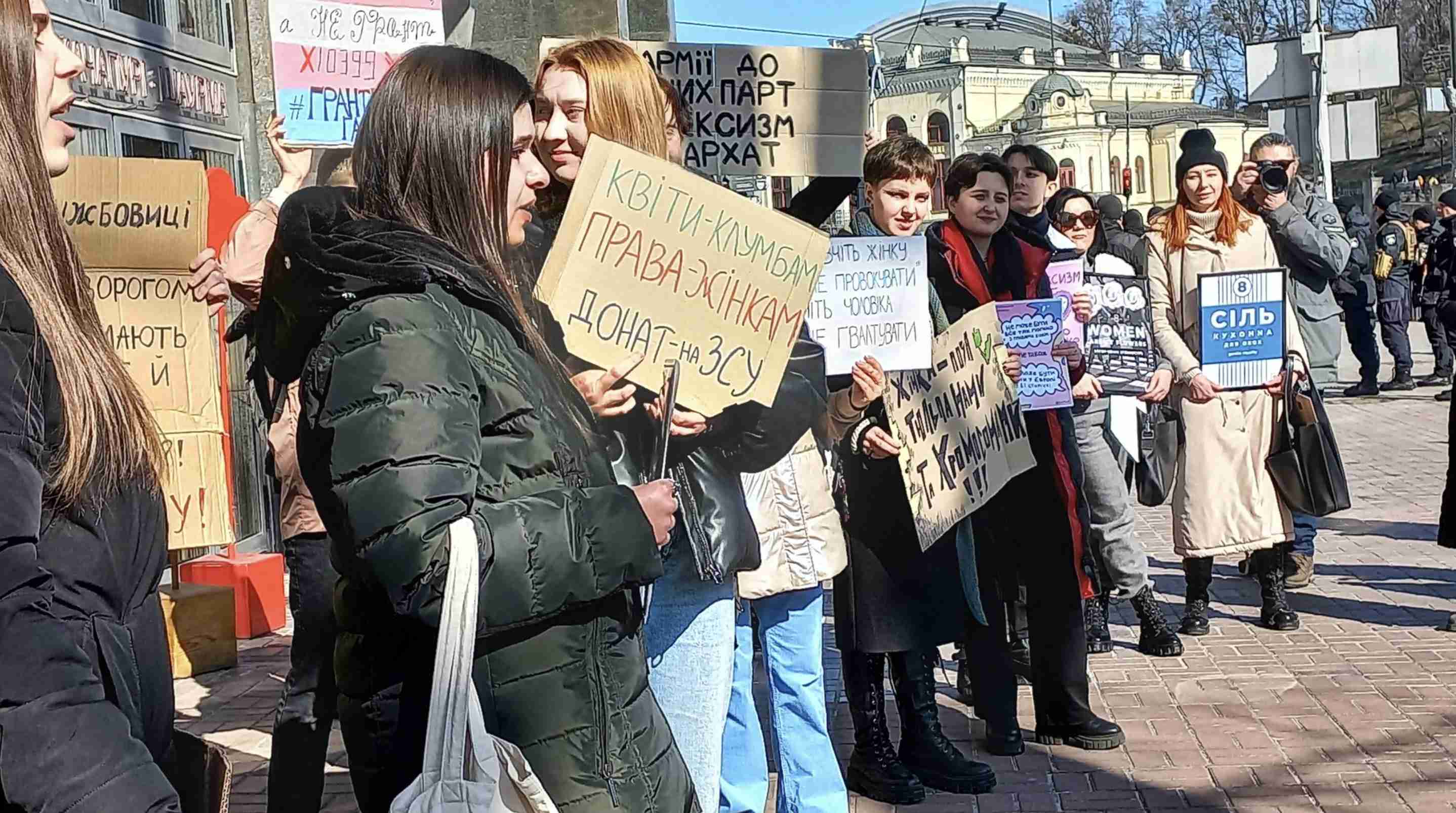
On March 8, international women’s day, activists staged a protest in Kyiv against sexism in all Ukrainian institutions, including the army. Photo from Katia Farbar’s twitter feed
The political conclusion from this is not that right wingers are more reliable allies than the US Democrats, German Social Democrats or UK Labour leaders. It is that we are dealing with a deep-going crisis of the western governments’ policy, of which “democracy” and social democracy are part.
The “democrats” and Social Democrats facilitate genocide in Gaza, because of their long-standing commitment to Israel, both ideological and strategic – just as the “left” and right of bourgeois politics facilitated the murderous attack on Iraq in 2003, for a similar complex of reasons. Now, these “democrats” see Ukraine through the lens of their policy on Russia. Leverage on the Kremlin is a principle for them; the democratic and social rights of Ukrainians are not.
Of course there are different ways to understand democracy-versus-authoritarianism. For example, just after Russia’s full-scale invasion of Ukraine, the writer Volodymyr Yermolenko used those terms to explain Ukrainians’ fierce and unexpected resistance:
Domestic authoritarianism in Ukraine is difficult to achieve and it has always been imported. Kyiv and Moscow differ substantially on political culture and civil rights. Ukrainians want to live in a democracy with guaranteed rights and freedoms, and they perceive Russia as a place where these values are neglected an tyrant’s power is respected.
I do not share Yermolenko’s rosy view of Ukrainian history. And I see creeping authoritarianism in wartime Ukraine (the concentration of power, constraints on parliament and on labour organisations) as dangerous. But I think Yermolenko is essentially right about the impact of the 2022 invasion on Ukrainian national consciousness:
However much the Kremlin may try to divide Ukrainians through false historical narratives, the distortion of facts and outright invasion and landgrabs, all its aggressive behaviour is bringing the Ukrainian nation together and strengthening the Ukrainian identity.
Here are pointers towards a view of “democracy” shaped by people, and developed and defended by collective action. For the western political elite, by contrast, “democracy” is enshrined in the state. For example, the Canadian politician turned academic Michael Ignatieff, in a speech made just after Russia’s initial invasion of Ukraine in 2014, pictured democracy as largely dependent on, and determined by, the US state:
The new authoritarians [leaders of Russia and China] cannot be changed, but they can be contained and they can be waited out. To that end, the United States should do what it can to keep the two authoritarians apart, to build relationships with each that offer them alternatives to greater integration with each other.
The US, said Ignatieff, “remains the democracy whose state of health determines the credibility of the liberal capitalist model itself in the world at large”. That model lies smashed and broken amid the unburied bodies of children in Gaza.
It is a basic socialist principle that democracy, and democratic rights, are rooted in struggles for social change, not in the American or any other capitalist state. This was essentially the view of it by 400+ Ukrainian activists, writers and researchers in a letter of solidarity with the Palestinian people in November:
Palestinians have the right to self-determination and resistance against Israeli’s occupation, just like Ukrainians have the right to resist Russian invasion. Our solidarity comes from a place of anger at the injustice, and a place of deep pain of knowing the devastating impacts of occupation, shelling of civil infrastructure, and humanitarian blockade from experiences in our homeland.
This is a minority view, a small beginning. It is where we need to start, I believe.
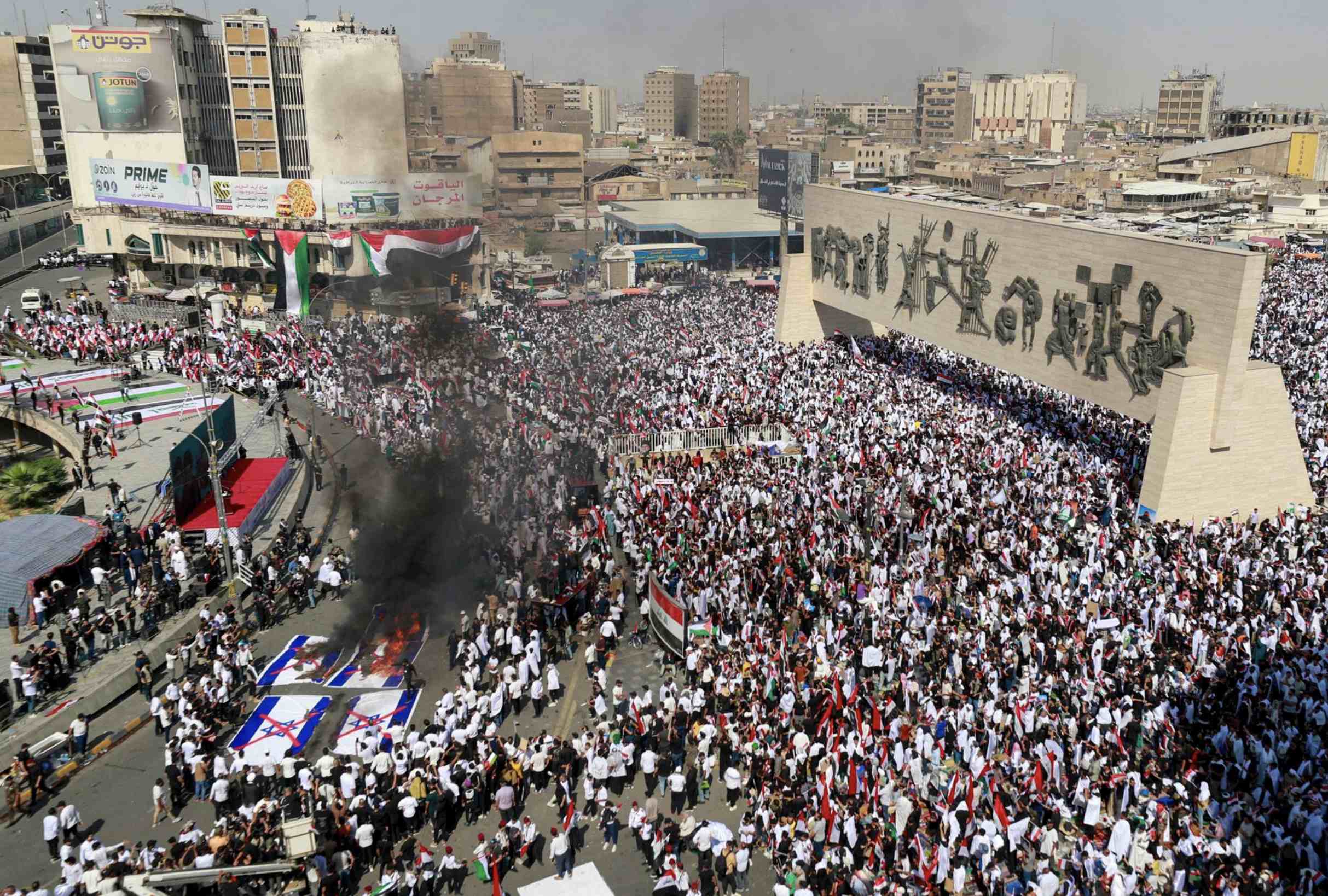
Protesters burn Israeli flags during a demonstration in Tahrir Square in Baghdad, Iraq, on October 13, 2023. Photo: Ahmad Al-Rubaye / AFP
6. The danger of a wider war
Europe is in a “pre-war era”, the newly-elected Polish prime minister Donald Tusk said on 31 March; the Russian devastation of Ukraine’s energy infrastructure showed that “literally any scenario is possible”. As socialists we may revile Tusk and the neoliberal political institutions in which he operates. But is this snapshot of the times we live in correct? I think it is. I do not understand this threat sufficiently to write about it in detail, but it needs to be recognised.
The American empire is in crisis, and Netanyahu, that empire’s attack dog, revels in expanding his war across the Middle East. Early this month he reacted to Israel’s deepening political crisis by ordering the bombing of the Iranian embassy complex in Syria.
The fear felt by millions of east Europeans, and voiced by Tusk, is that Putin, the American empire’s frankenstein monster, will also seek to expand his war beyond Ukraine. (The Insider (Russian opposition media) published a survey of views on this.)
It is a matter of socialist principle, as I understand it, that war by its nature tends to confound, block and weaken our hopes of changing the world through collective action, of strengthening society against the state, of finding ways to push back, supercede and defeat capitalism. But this does not mean we oppose all wars in all circumstances: wars of the oppressed against the oppressor, and wars of resistance to tyranny and dictatorship, can be, and in cases such as Ukraine and Palestine, are, justified.
If we are indeed entering a pre-war period, we will need to develop our understanding of the types of wars we may face. Will we see wars analogous with the Italian assault on Eritrea (1935)? The Japanese empire’s war on China (from 1937)? The Soviet invasion of Finland known as the “winter war” (1939)? Would we oppose arms deliveries to the defending side in each or all such cases of aggression? Again, I will not develop this theme here, just recognise that we need to think about it.
Hopefully, we can avoid speculation about how this pre-war era might unfold, as a substitute for dealing with the actual wars raging now.
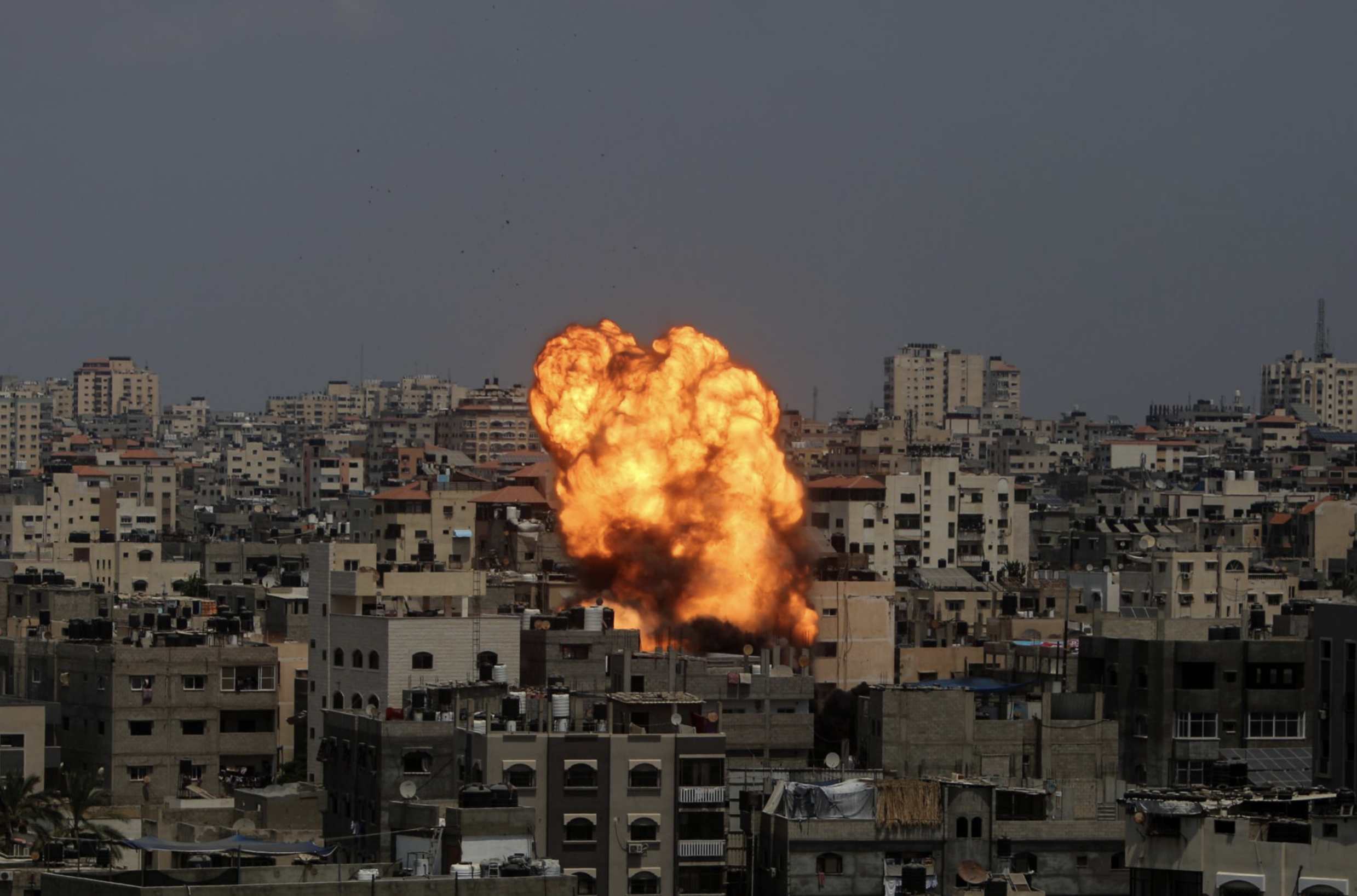
Israeli airstrike on Gaza, August 6, 2022. Photo: Mohammed Dahman / Getty Images
Conclusions
In May 2022 a branch of the Stop the War coalition arranged a debate between Lindsey German, a leading spokesperson for Stop the War, and me. She cancelled at the last minute, and I wrote her an open letter, which said:
In May [2021], you wrote that Stop the War is “supporting the people of Palestine, who have a right to resist occupation”. I agree with that. But why no such statement about Ukraine?
And if Ukrainians, or Palestinians, have a right to resist, what does it mean? Does it only mean standing up to tanks with your bare hands, as Ukrainians have had to do? Does it mean throwing stones, often the only weapons that young Palestinians have? What about proper weapons? Do you think Palestinians have a right to those? And Ukrainians?
I said then that I didn’t think these questions are easy to answer, and I still don’t. But I have not changed my view: the labour movement should not oppose the delivery of weapons to Ukraine by western governments, as Stop the War does. Because Ukraine’s war remains essentially a war of resistance to imperial aggression.
The arguments that Ukraine is fighting a “proxy war” for NATO are based in Kremlin-influenced mythology. (I have written about this in a linked article.) These arguments do not correspond to the actual position of the western powers (see section 4 above) or Russia (section 2 above). We need to address the actual war being fought, not one that exists in “left” propagandists’ heads.
In this actual war, I fervently wish for the defeat of the Russian invasion and withdrawal of all Russian forces, as the basis for a just outcome. But for the reasons discussed above, I do not think it is the most likely one in the short term. In the next year or so, I think it is more likely that either (i) Russian forces fail to push further forward, and retain only limited parts of eastern and southern Ukraine, or (ii) that Russian forces succeed in pushing further forward.
Thus the most likely choice facing most Ukrainians, in the short term, may be between living in a highly imperfect bourgeois democracy, increasingly dependent economically and politically on the European Union (as most do now), and living under puppet occupation administrations of a fascist, or near-fascist, Russian regime.
Socialists can not be neutral about this. We are for the defeat of the imperial power, and for every blow that the Ukrainian resistance can strike at it. In other words, we recognise Ukrainians’ right to fight to live under Zelensky, as opposed to being ruled by lawless thugs.
This is certainly related to our long-term aspiration, to strengthen the working class movement, and civil society, to build its power in opposition to the power of capital and its political elites.
As for future peace talks, time will tell. In my view they are far away. Calling for peace talks, without recognising the way the Kremlin uses that narrative, is naïve. We can put pressure on western governments to adopt policies that help Ukrainians survive the war and build better lives after it – which includes not starving Ukrainians of the weapons they need to defend themselves; cancelling Ukraninan debt; stymying the tide of neoliberalism being prepared by UK, US and European institutions to let loose on post-war Ukraine; and supporting the most robust possible future security arrangements in the face of Russian expansionism.
We need also to recognise the limits of our ability to influence governments, and to build on the wealth of direct solidarity initiatives support Ukrainian labour and civil society, by the UK and European labour movements over the last two years (see e.g. here, here and here).
Another vital element in this process is to build relationships between the movement in western countries, in eastern Europe, and across the global south, where the war in Gaza has produced a wave of revulsion against imperialism, and determination to defeat it, in a new generation. SP, 8 April 2024.
Footnotes
- ^ With many thanks to T, D and others who have commented on a draft version.
- ^ Note that I only suggest some directions in which the labour movement and social movements could go, because they are the agents of change that matter. I do not write about what governments could or should do; I do not see politics that way.
- ^ I expressed my opinion on both these issues in April 2022, in this article.
- ^ The Russian state conceals information about casualties. The most accurate information on Russian losses is from the joint project by Mediazona and Meduza. Western publications including the Economist and Newsweek have assessed those estimates as credible. On the Ukrainian side, the estimate of 42,000 is from Meduza/ Mediazona. On the second anniversary of the Russian invasion, president Zelensky said 31,000 Ukrainian soldiers had died.
- ^ The US-based Institute for the Study of War also recently published a report on the occupied territories. Despite its clear political bias, the factual material is accurate.
- ^ B. Grozovskii, “Russia’s Unprecedented War Budget Explained”, The Wilson Centre: the Russia File, 7 Sept 2023. Grozovskii includes in his estimates budget items labelled military, plus those labelled “secret”. There are lower numbers in: V. Ishchenko, I. Matveev and O. Zhuravlev, “Russian Military Keynesianism: who benefits from the war in Ukraine?”, Ponars Eurasia policy memo, November 2023.
- ^ Ishchenko et al, “Russian Military Keynesianism”; “Novye rossiiski regiony okazalis’ dotatsionnymi pochti no 90%”, Forbes.ru, 5 June 2023.
- ^ “Ukraine war facilitates Kremlin ‘deoffshorisation’ dream”, The Bell 8 March 2024; Novaya Gazeta Evropa, “Iz’iato dlia SVOikh”, 5 March 2024; “Putin’s Reshuffle: deprivatisation as a ‘national project’ for elite reformatting”, Re: Russia, 7 March 2024.
- ^ A. Prokopenko, “Oligarchs are losing out as Putin courts a new class of loyal asset owners”, Financial Times, 4 Oct 2023.
- ^ A. Prokopenko and A. Kolyandr, “Keynes in jackboots: can defense spending sustain Russian economic growth”, The Bell, 23 June 2023; “The surprising resilience of the Russian economy”, Financial Times, 2 February 2024.
- ^ See “Ukraine needs 500,000 military recruits. Can it raise them?”, Financial Times, 13 March 2024; OSW Commentary, On the threshold of a third year of war. Ukraine’s mobilisation crisis, February 2024; and “Draft dodging plagues Ukraine”, Politico, 25 March 2024. Surveys reported in the Financial Times article, and here and here.
- ^ I wrote about the Nord Stream issue here and about the “republics” here.
